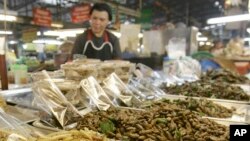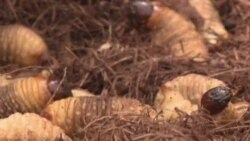A new study by the U.N. Food and Agriculture Organization (FAO) says insects could be used in the fight against hunger and to increase food security.
A report released Monday says that forest insects form part of the traditional diet for some two billion people worldwide and are a readily available source of nutritious and protein-rich food.
Some of the most widely consumed insects include beetles, caterpillars, bees, wasps and ants. The food agency report says insects are rich in protein, good fats, iron and other minerals.
Watch related video about insect consumption
The report cites the "disgust factor" as being a large reason as to why eating insects is rare in Western countries, an effect that trickles down to much of the world. It also suggests chefs can help raise the status of insects by incorporating them into recipes and menus.
Insects produce a fraction of emissions such as methane, ammonia and greenhouse gases compared to other animals, according to the FAO. It adds that on average, insects use just two kilograms of feed to produce one kilogram of meat, compared to cattle which require eight kilograms of feed to produce the same amount.
The food agency also pointed out that in addition to food, insect gathering and farming can also offer employment and income generation for people and businesses.
A report released Monday says that forest insects form part of the traditional diet for some two billion people worldwide and are a readily available source of nutritious and protein-rich food.
Some of the most widely consumed insects include beetles, caterpillars, bees, wasps and ants. The food agency report says insects are rich in protein, good fats, iron and other minerals.
Watch related video about insect consumption
The report cites the "disgust factor" as being a large reason as to why eating insects is rare in Western countries, an effect that trickles down to much of the world. It also suggests chefs can help raise the status of insects by incorporating them into recipes and menus.
Insects produce a fraction of emissions such as methane, ammonia and greenhouse gases compared to other animals, according to the FAO. It adds that on average, insects use just two kilograms of feed to produce one kilogram of meat, compared to cattle which require eight kilograms of feed to produce the same amount.
The food agency also pointed out that in addition to food, insect gathering and farming can also offer employment and income generation for people and businesses.







